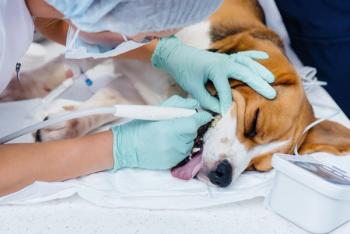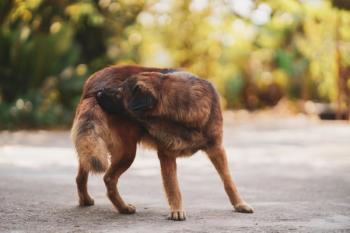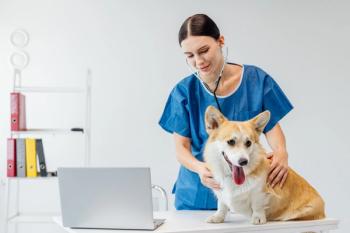
- dvm360 July 2022
- Volume 53
- Issue 7
Healing orthopedic injuries
Have you had a lameness case that wouldn’t get better? It could be a good time to try a different approach
As a sports medicine and rehabilitation specialist, I encounter numerous cases of chronic lameness in patients who are overly rambunctious. These energetic and sometimes anxious dogs pull on their leash and jump on and off furniture. They are receiving all the appropriate treatments: pain medication, instructions for activity restriction, and rehabilitation. But they are not getting better. Why?
The missing link is appropriate behavior modification. As it turns out, injuries can be healed.
- Signalment: 1 year, 9 months; female, spayed Bernedoodle
- Presenting complaint: recurrent right thoracic limb lameness
Diagnostic imaging (MRI and musculoskeletal ultrasound) revealed:
- Severe right partial proximal biceps rupture and tenosynovitis
- Left biceps enthesopathy with partial tear and tenosynovitis
- Bilateral medial coronoid disease
- Bilateral shoulder osteoarthritis
Treatment protocol
The patient received extracorporeal shock wave (ECSW) therapy followed by intraarticular and intralesional platelet-rich plasma (PRP) therapy to both shoulders for a series of 3 treatments 2 weeks apart. The treatment of shoulder tendinopathy with both ECSW and PRP is well documented.1-3 In addition, the patient received formal rehabilitation therapy for 6 weeks along with instructions for activity restriction and a home exercise plan designed to strengthen the shoulder stabilizers and core musculature. She did beautifully, and the lameness resolved.
Unfortunately, the lameness recurred when she returned to day care 4 months later. She presented nonweight bearing lameness on her right front limb and severe pain upon palpation and stretching of her right biceps tendon. Understandably, the owner was frustrated to see her dog reexperiencing lameness after all she had invested. She expressed it was impossible to restrict her pet’s activity. She described her dog as “crazy” and having attention deficit hyperactivity disorder (ADHD). This is when we called Steve Dale.
In addition to my prescriptions to help with behavior modification (trazodone 5 mg/kg by mouth 3 times a day, gabapentin 10 mg/kg by mouth 3 times a day, and Purina Calming Care supplement), Steve prescribed a no-pull harness (Ruffwear Web Master Harness and PetSafe Easy Walk Dog Harness).
We may try to avoid anthropomorphizing, but dogs may experience disorders similar to ADHD. Questionnaires have been developed to help identify such conditions in dogs.4 To address our patient’s ADHD symptoms, we recommended introducing more enrichment and relaxation protocols like dog puzzles, unpredictable feeding times, and hidden food and treats around the house.5 She was also enrolled in nose work classes, which stimulated her mind without putting her body at risk for reinjury. The no-pull harness made it easier for the owner to walk her in a controlled manner, allowing her to exercise safely and regularly.
As our patient learned the new behavior techniques and resumed rehabilitation and appropriate exercise modification, her lameness resolved and has not since recurred. The combined approach of our rehabilitation strategies and behavioral medication allowed our rambunctious Bernedoodle to finally heal and be happy again.
Leilani Alvarez, DVM, DACVSMR, CVA, CCRT, is a senior veterinarian, specialist in sports medicine and rehabilitation, service head of integrative and rehabilitative medicine, and director of the Tina Santi Flaherty Rehabilitation & Fitness Service; Schwarzman Animal Medical Center, New York, New York.
References
- Becker W, Kowaleski MP, McCarthy RJ, Blake CA. Extracorporeal shockwave therapy for shoulder lameness in dogs. J Am Anim Hosp Assoc. 2015;51(1):15-19. doi:10.5326/JAAHA-MS-6175
- Leeman JJ, Shaw KK, Mison MB, Perry JA, Carr A, Shultz R. Extracorporeal shockwave therapy and therapeutic exercise for supraspinatus and biceps tendinopathies in 29 dogs. Vet Rec. 2016;179(15):385. doi:10.1136/vr.103487
- Canapp SO Jr, Canapp DA, Ibrahim V, Carr BJ, Cox C, Barrett JG. The use of adipose-derived progenitor cells and platelet-rich plasma combination for the treatment of supraspinatus tendinopathy in 55 dogs: a retrospective study. Front Vet Sci. 2016;3:61. doi:10.3389/fvets.2016.00061
- Vas J, Topál J; Péch É, Miklósi Á. Measuring attention deficit and activity in dogs: a new application and validation of a human ADHD questionnaire. Appl Anim Behav Sci. 2007; 103(1):105-117. doi:10.1016/j. applanim.2006.03.017
- Overall KL. Protocol for relaxation: behavior modification Tier 1. In: Manual of Clinical Behavior for Dogs and Cats. Elsevier Health Sciences; 2013.
Articles in this issue
over 3 years ago
Z is for zebras and other dental surprisesover 3 years ago
Practice ownership perksover 3 years ago
3 steps to protect your practice from ransomwareover 3 years ago
Colic surgery delivers a painful reminderover 3 years ago
Hiring isn't all about moneyover 3 years ago
Dermatology image quizover 3 years ago
Protecting adopted pets from heartworm diseaseover 3 years ago
The A — Z on ADA complianceNewsletter
From exam room tips to practice management insights, get trusted veterinary news delivered straight to your inbox—subscribe to dvm360.




